Amazingly, Reims interrupted Rennes’ streak of nearly 20 games without a loss. Under Bruno Génésio, Rennes have seen an incredible run in which their full potential has been realised. The best season in club history has unquestionably begun for Rennes, who are now in the fourth position.
After a five-match winning run, Génésio’s side is currently ranked in the top four of all five of Europe’s major leagues, putting them on track for a historic season. Their close competition is up top with Lens, the surprise one, Marseille and the mighty PSG.
Oscar Garcia was fired by Reims, the fourth Ligue 1 team to do so since Sunday. Garcia was replaced by experienced gamer William Still, although the 30-year-old is still one of the youngest managers in the top league in Europe.
Garcia’s team came in bottom place in France’s first league with only one victory in ten games. So, Still, the assistant was appointed interim manager. Reims was persuaded to make him a permanent after his 9 points were earned in his five games before the World Cup.
Since choosing to make a career out of coaching, he has spent most of his time as an assistant coach. The Belgian-English national has prior experience with a team aimed to get promoted to the Belgian Pro League from the second tier.
Génésio, 56, is notable for having coached OL for four years before his time with Beijing Guoan in China (2019-2021). Rennes has played sixteen games this season and only lost three, including this one.
This tactical analysis will examine how Still was able to overcome a championship-contending team despite the statistical disadvantage. This analysis will also include the use of both managers’ tactics to mould the team.
Lineups
Will Still’s squad have recorded the second youngest average age in the starting line-up with an average of just 24. He preferred 4-4-2 over his usual 4-2-3-1 to face the newly unrivalled Rennes.
He started with Yehavnn Diouf who has featured nine times out of a total of 16 this season. After Still’s takeover, the youngster has seen the highest features in his career. Yunis Abdelhamid and Emmanuel Agbadou, the Ivorian international, started as the left and right centre-backs, with Thibault De Smet and Thomas Foket’s company as the left and right full-backs.
Marshall Munetsi, the Zimbabwean, paired up with Azor Matusiwa, the constant for Still. Arbër Zeneli, the number ten of Reims started as the left-winger who has been the main outlet for problems. Junya Ito, the Japanese, fell on right-flank. Folarin Balogun, the Arsenal loanee, teamed up with an interesting choice, Alexis Flips, usually a right-back and occasionally a winger.
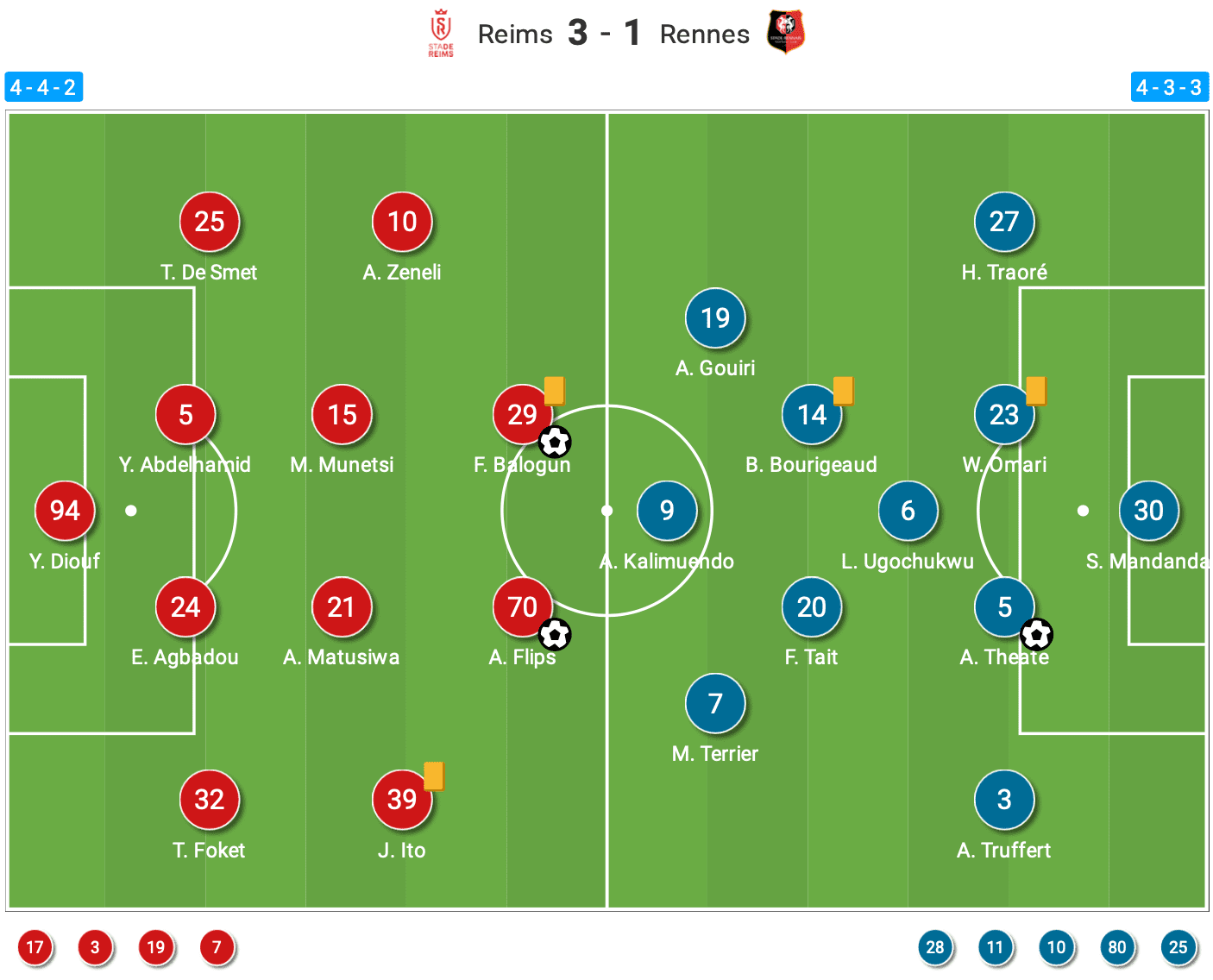
Since arriving at Rennes, Génésio has secured over 55.4% of win percentage to his total 83 games. His decision to use a 4-3-3 system was unexpected given that his previous triumphs largely employed a 4-4-2 configuration.
Steve Mandanda, the ultimate choice for Rennes, started between the sticks. Arthur Theate and Warmed Omari played as the left and right centre-backs. The young Adrien Truffert and the experienced Hamari Traoré played as the left and right full-backs.
Lesley Ugochukwu played as the single pivot, with Benjamin Bourigeaud and Flavien Tait just above. Martin Terrier and Amine Gouiri served as the left and right attackers with Arnaud Kalimuendo, the 20-year-old, in the central attack.
Still’s impact on Reims’ counter-pressing
William Still’s impact on the team’s pressing has effectively increased the team’s energy also bringing the passion back at Stade Auguste Delaune. His approach involves aggressive pressing no matter what. Every player of Reims gave their best to increase the work rate to compete against a team like Rennes.
After his takeover, Still has visibly taken a stand in approaching things. He prefers his style to be more dynamic and involved, to make use of every eleven inside the pitch. His energy in the squad is clear as day, with everyone putting their hearts and souls into it. The energy put to retrieve the ball in the opposition’s half was quite incredible from Still’s men.
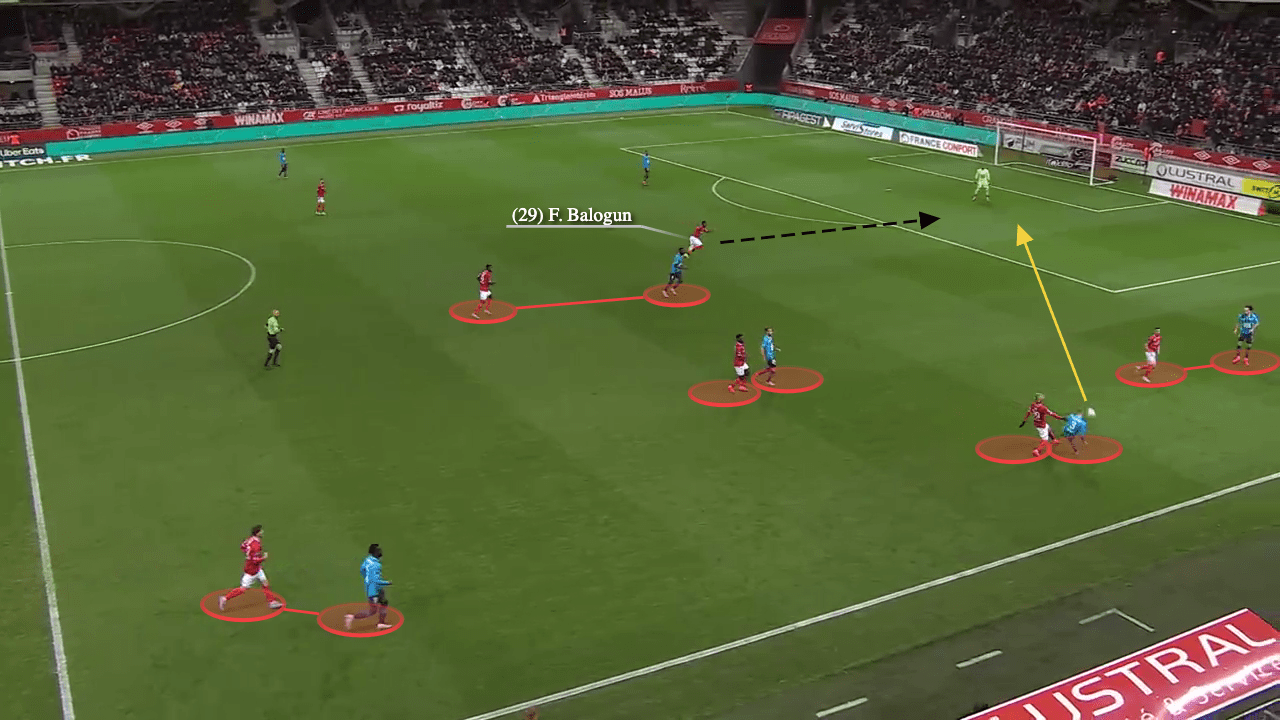
The above shot demonstrates Reims’ ability to commit almost seven of their players into Rennes’ half to press and win the ball. It was now 7v8 including the keeper. Balogun quickly reacted to the pass being made in the above shot and as a result, Mandanda panicked and gave the ball away to Zeneli.
Reims, in a way, harassed Génésio’s men while putting their energy into work and aggressively winning the ball in Rennes’ half. The energetic minds in the home ground contributed very well to their attacking phase.
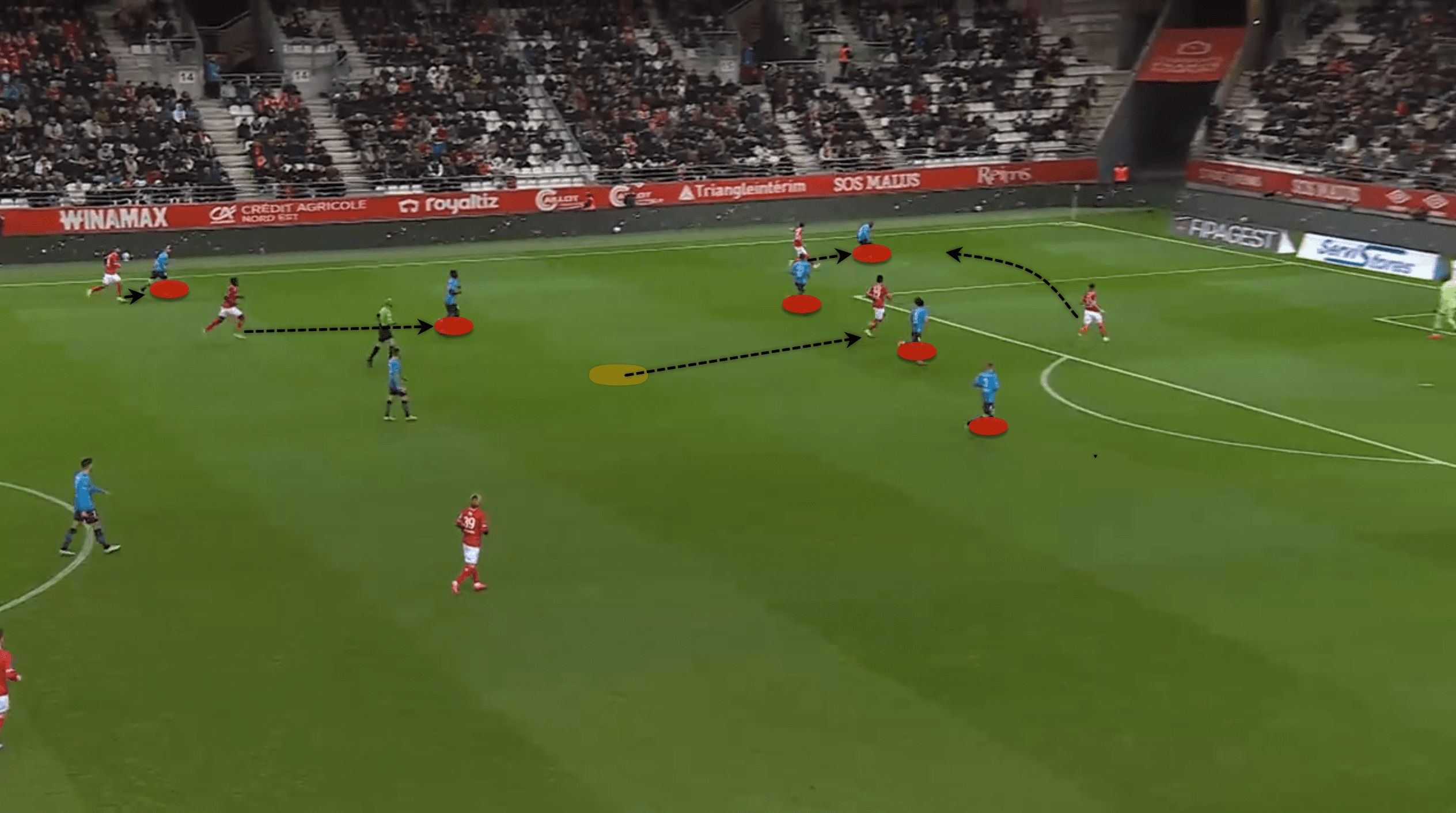
The above image is a picture which shows what Reims are. Once, after a corner in the 80th minute, the ball was spilt out in the box and fell into the feet of Doku. Still’s men were on an agenda to go out aggressively and face the technical youngster. The energy, so late in the game, displayed Reims was full of hope under the new boss although the play ended with a foul.
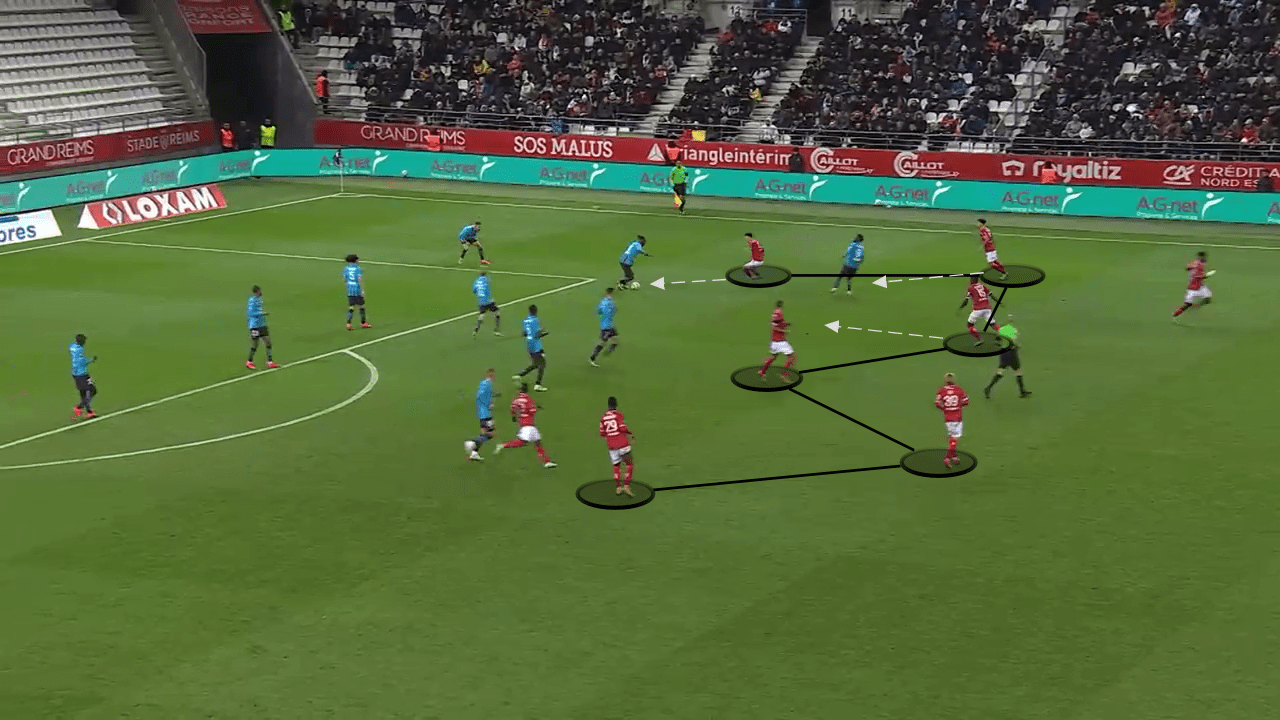
All of the counter-pressing chances have gifted them opportunities to counterattack against the away side. Thus, to finish off, Reims had 4 counterattacks of which 1 ended up with a shot. Rennes, in contrast, had only 2 counterattacks, both without a shot.
To conclude this topic, before William Still’s takeover, Reims had an average of 12.75 passes allowed per defensive action which doesn’t seem like a pressing side. Now after his takeover, the side has 10.5 PPDA which is an astonishing growth in just fifty days of coaching. Still has rejuvenated the intensity and energy of the Stade Auguste Delaune.
Reims’ compact structure
Still’s plan for an attacking side and a high-possession team was displayed in the game. Reims were comfortable defending in a low or a mid-block. The lines were perfectly aligned and symmetrical and all the players put their minds to it. As impressive as it was, not even a single player let the team down by not recovering back to maintain the defensive or the midfield structure.
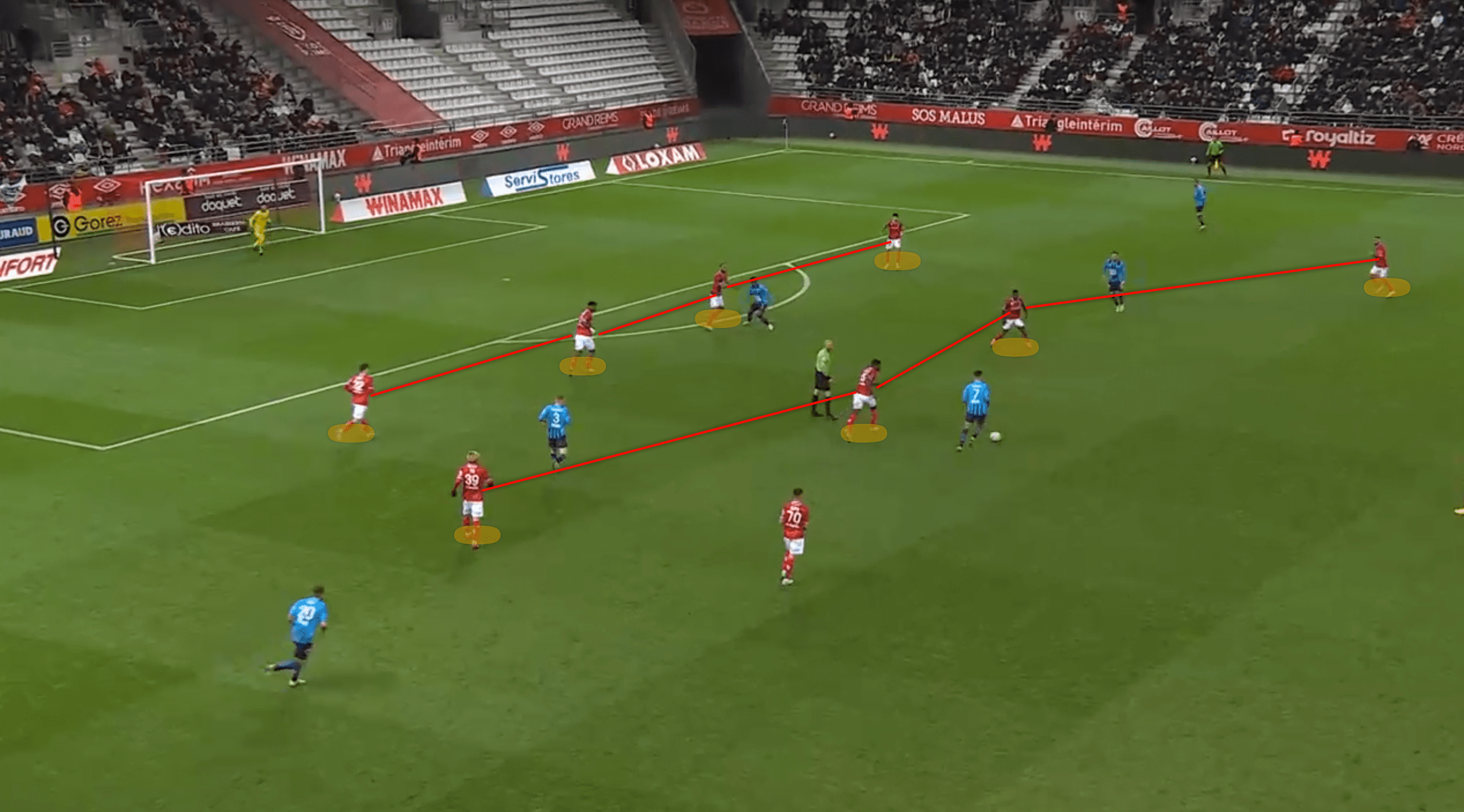
Though Rennes began to generate numerous chances in the second half, they weren’t able to penetrate the compact structure formed by Reims. The recovery part played the most important part in it as Reims always seemed to double up on the players.
The perfect organisation was a collective effort by the defenders to often coach the players as seen in the below shot. Two of the Reims’ defenders call the midfielders to adjust the position despite being in a compact one. This attitude to be perfect at all times or ensuring it was of big help.
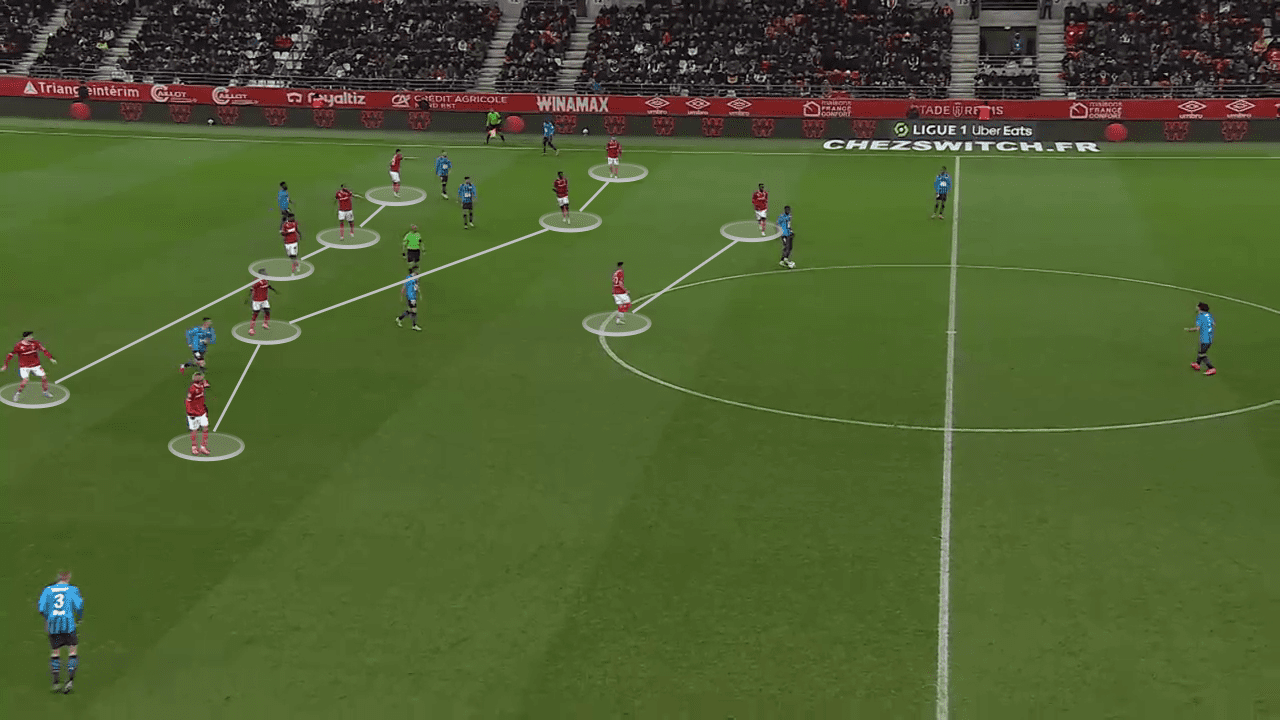
In the first half, rather we witnessed a lot of doubling up and were crazy to see the energy inside the players. On an occasion, the attacking midfielder of Rennes was forced to the sideline, and Munetsi straight away engaged in the duel. Ito’s support to the defensive phase was incredible as the quick winger always helped the midfielders to double up like in the picture below.
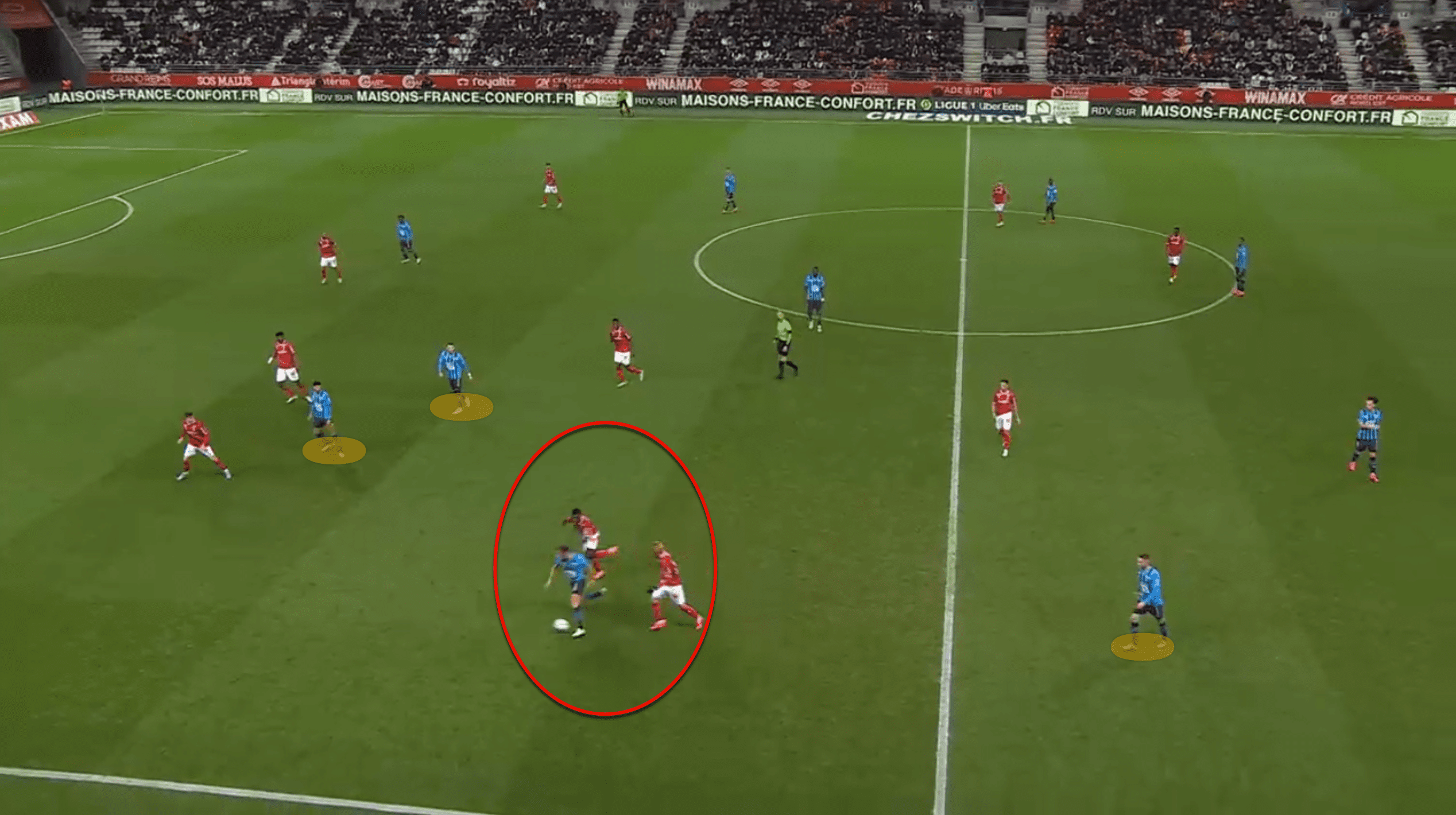
A similarity in all of the pictures displaying the structure has one common thing. The half-spaces mean a lot to Still. He doesn’t want the opponents to play through the spaces between the lines. The instruction was very well received by the players, as they let no space or player be in that area.
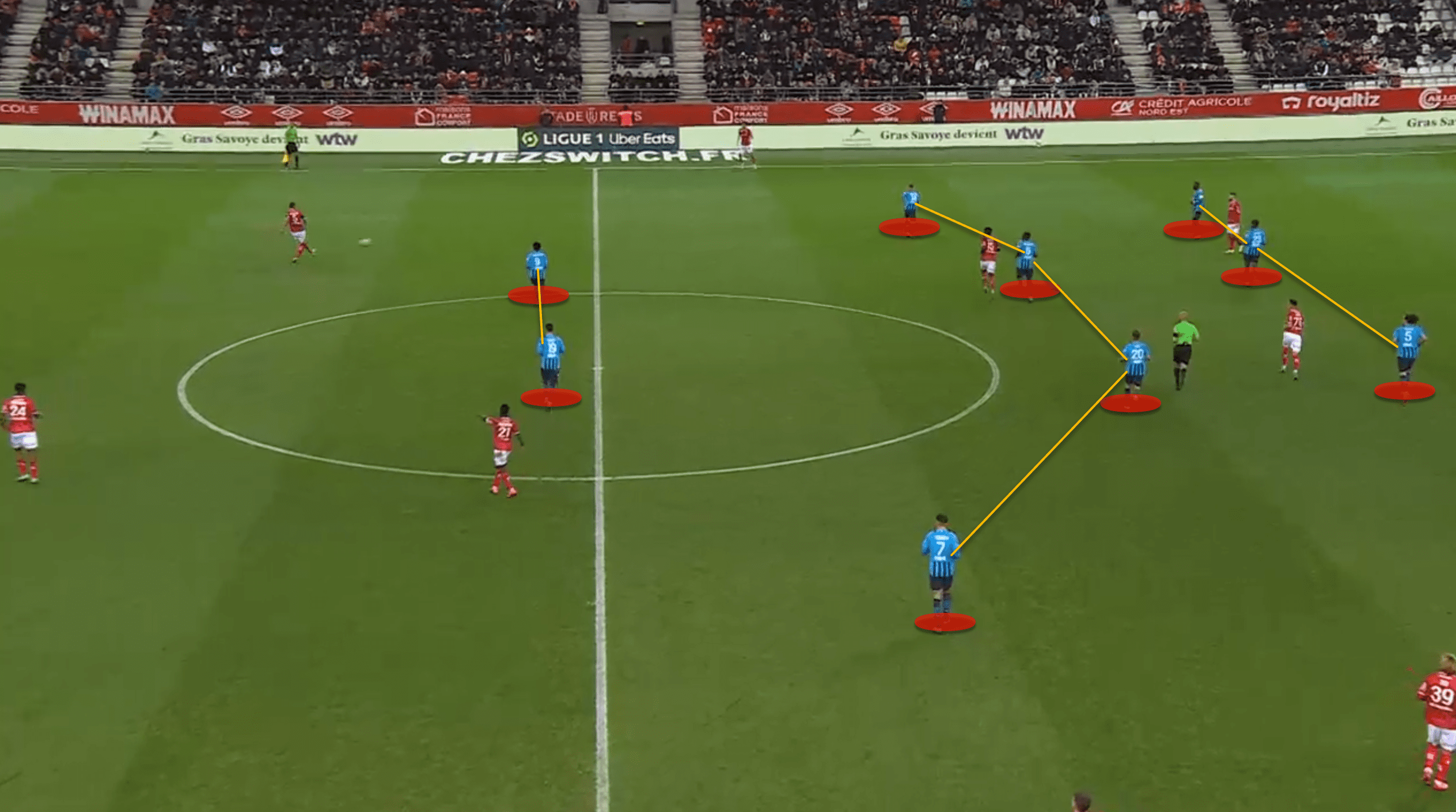
In most situations, we see a large gap between the attackers and the midfield line but not with the other two. The defensive line made sure they allowed no space between them and the midfielders above. The shape provided them with the stability to defend all sorts of situations against the mighty Rennes.
One of the fewest times when Rennes had a clear-cut chance came when they were able to find the ball into the half-spaces. The below picture is one such scenario where the gap between Reims’ defensive and midfield line carried a crucial threat. The huge gap was quickly exploited by the attacking midfielder of Rennes.
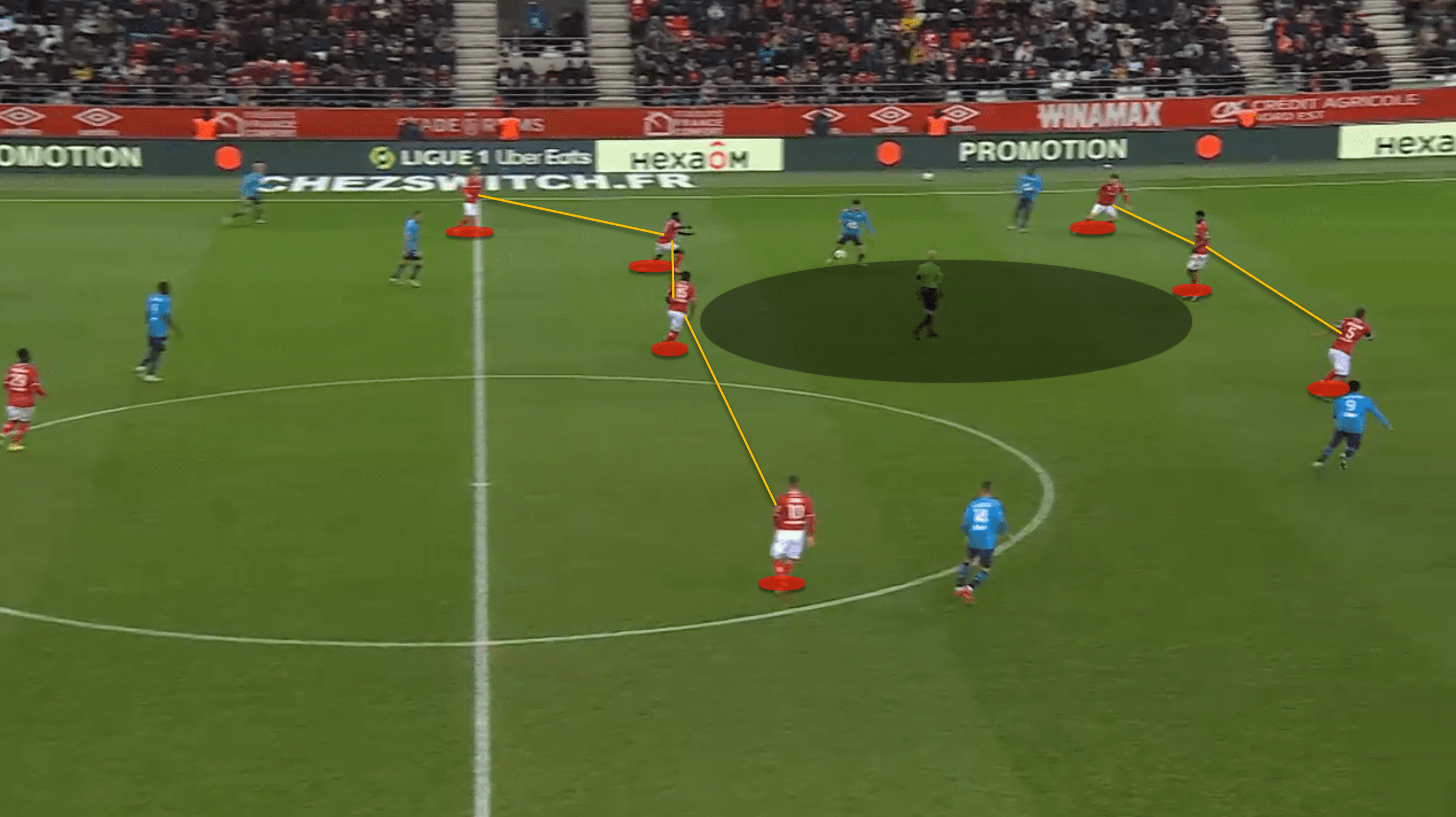
To summarise, Rennes made 42 positional attacks, but only six of them were converted with a shot. Reims, on the other side, generated just 20 attacks, less than half of Rennes’, yet finished with the same number.
Nullifying Rennes’ backup plan
Rennes always had a plan and a backup plan if plan A didn’t work. Génésio’s priority was to exploit the spaces between the line which was awarely defended by Still. The plan B carried out by Rennes was vivid because of the flank play occasionally adopted by the team.
Rennes implemented methods to attack over wide areas roughly thirty minutes into the game. It was almost as though Reims expected them to modify their strategy since it was their only choice.
When things didn’t go as planned, they went wide and used flank combinations to land crosses. The image below depicts one of the moments in the first half in which Rennes entirely disregarded the wide spaces.

The full-backs Truffert and Traoré were used in a very minimal way, where Reims’ vital options were them. In the left image at the top, the centre-back rides up front to make a pass to the midfielder inside. Three seconds later, the right image indicates how the midfielder denied a through ball to the running full-back even when the defender had committed.
Talking about the usage of wing-backs, Reims’ ideal outlets were De Smet and Foket to neutralise the imbalance. The below shot will explain the wide usage of space where Zeneli went inside to give space for the De Smet to join in.

This is a usual action performed by the flank men to create space and to play combinations along. Still’s adamancy to involve the full-backs more frequently gave them the wings to fly across the sides.
Rennes almost had double the crosses of Reims, an astonishing 20. Despite their combinations being remarkably good on the flanks, the home side was confident to defend and cover the nearby duels. It was always an additional man to help defend the situation.
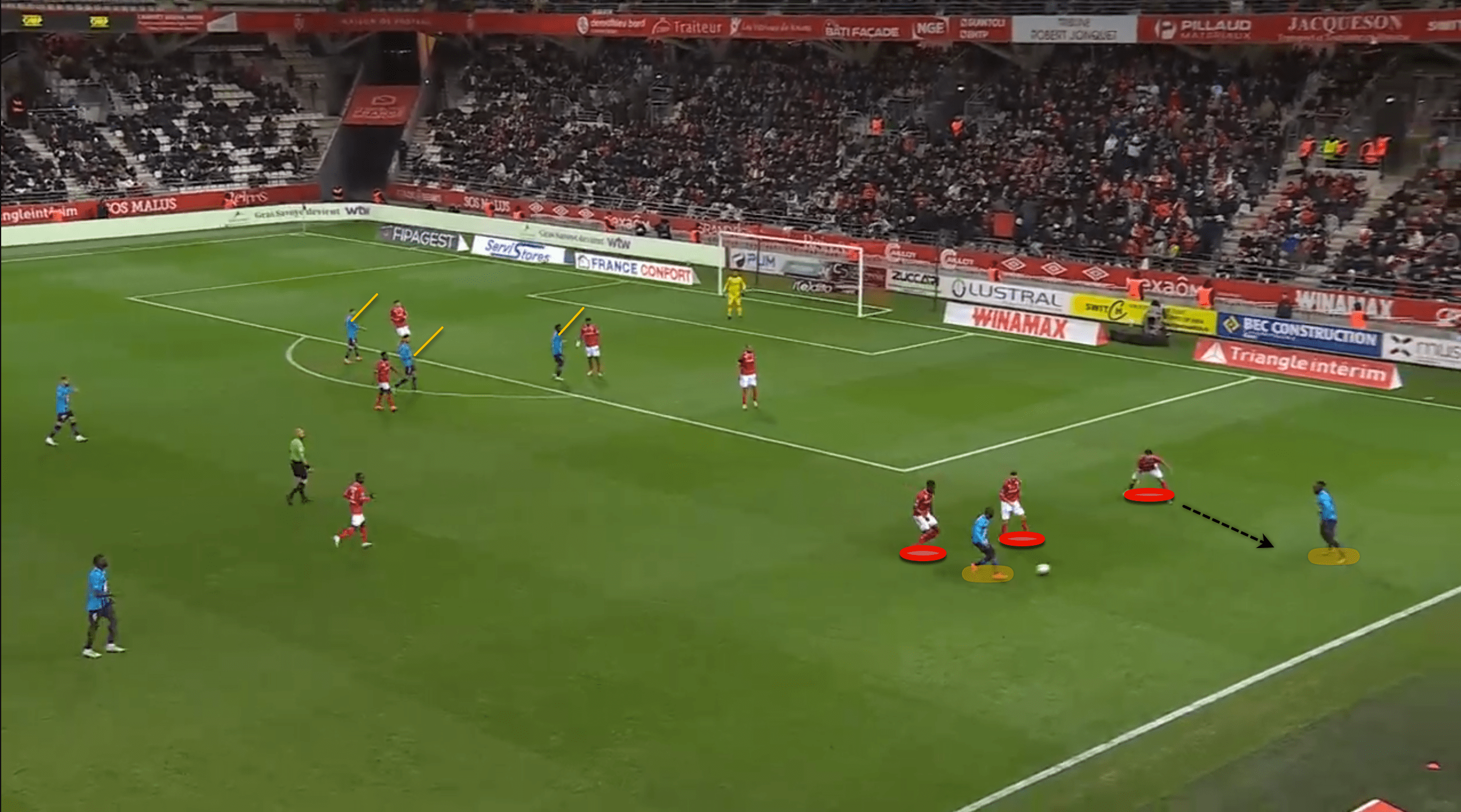
The work rate by the midfielders was immense as to how they took up all the nearby duels to offer cover. In the above image, three Rennes attackers wait for a cross into the box. Unfortunately, Rennes could not produce a cross as they faced a 2v3 situation.
Reims were well aware of how Rennes could create opportunities from crosses. As in the below image, Rennes was left with no choice but to approach through flank plays. The defenders waited patiently to position themselves, keeping the attackers in the hindsight. The below situation ended up with Reims throttling off the threat to cross and successfully defending the situation.
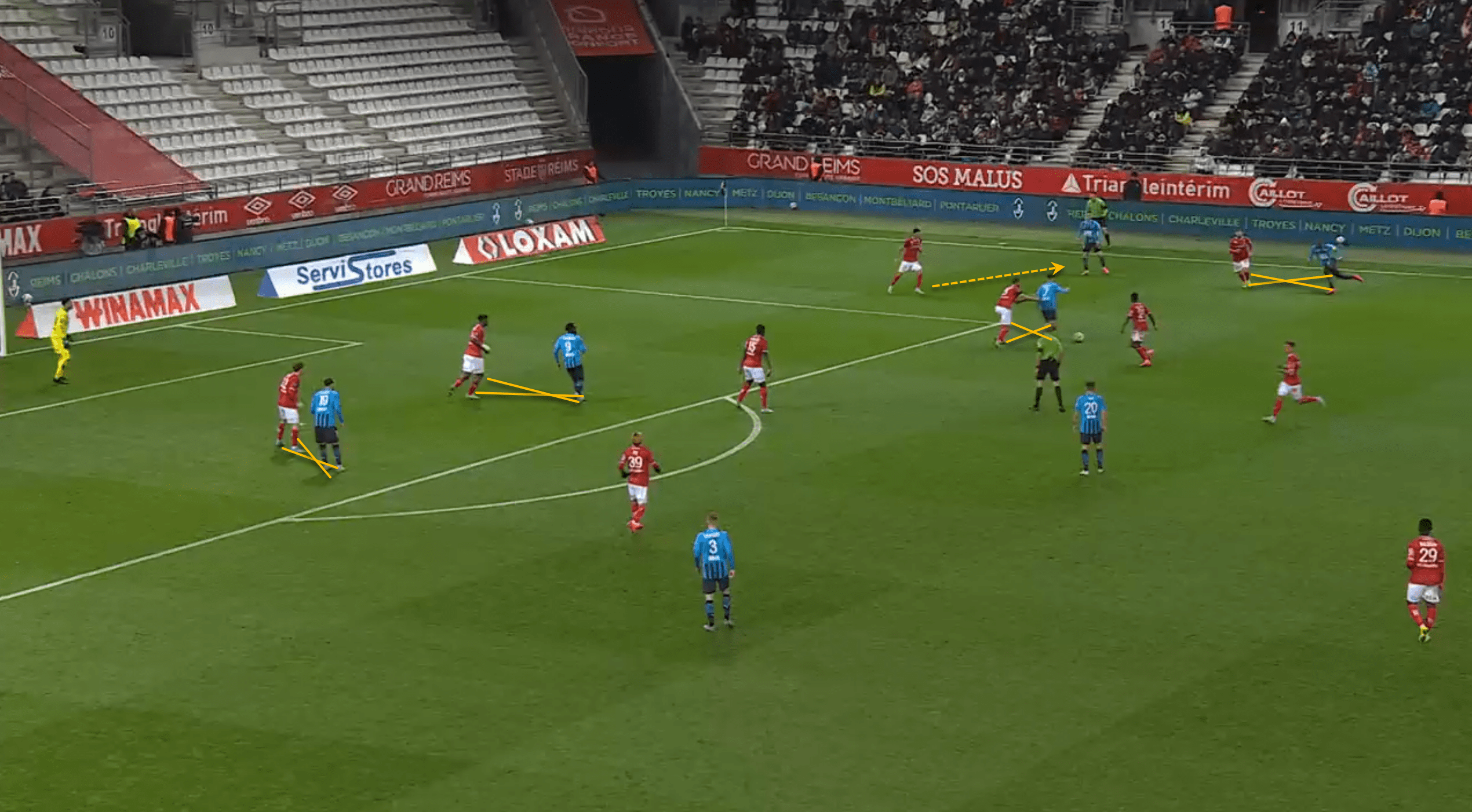
These were seen almost frequently until Rennes’ flank players weren’t doubled up. Rennes were only able to threaten with crosses when Reims were unable to have more up on the crossers. The image below is one of the situations where Bourigeaud was free enough to put a cross on the only man running into the box.
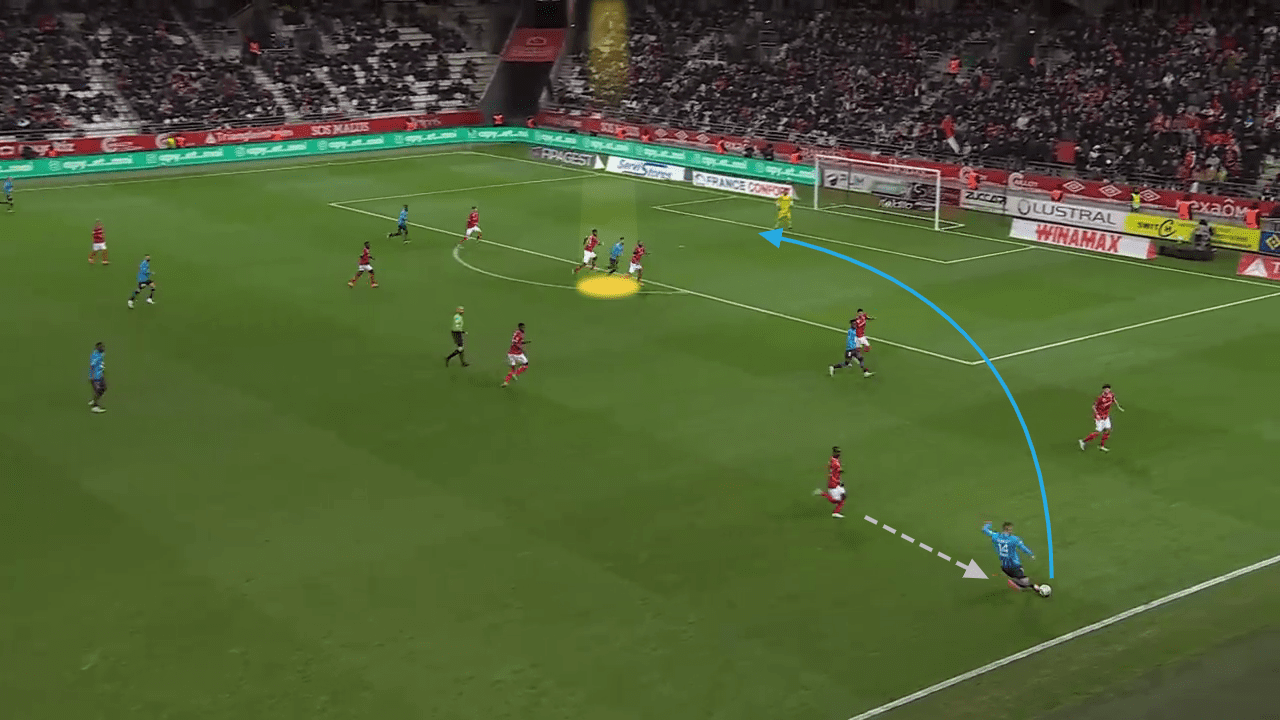
The defenders were able to successfully defend the cross by sandwiching the striker as seen in the above shot. Although the cross was accurate as the crosser was under no pressure, Rennes could barely create a chance out of it.
Though the pacy winger, Jérémy Doku was brought on the left flank, Rennes struggled to get past the wave of defenders. The covering ability displayed by Reims was immense. Every player had duty after duty to put teamwork above everything else. His pace and technique brought Rennes the hopes to make a comeback in an away fixture, he was brilliant.
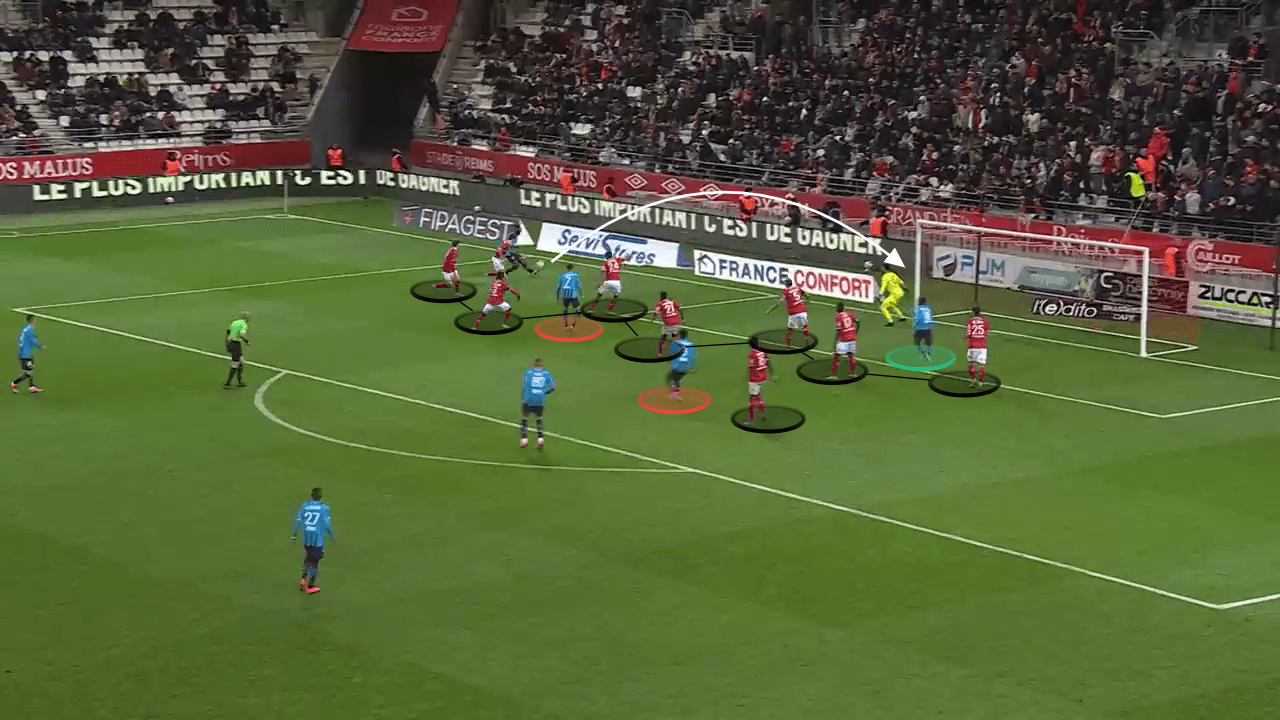
Doku’s flair and his sudden burst of speed allow him to glide through opponents and at times deliver crucial crosses. His abilities offer him to be in a better crossing position than any other on the pitch but the crosses were not met inside the box as a result.
Rennes’ three players inside the box were ineffective in their positioning as only one managed to get inside the danger zone. The other two were clueless about what to do and where to be. What made it harder for them is Reims’ manpower in the box, having almost nine players inside their box. All thanks to the collective effort put in by the players.
Conclusion
Reims’ midfielders put out a great effort to display what they and the team are capable of. Especially, a big thanks to Munetsi and Matusiwa who conquered the midfield with their aggressive character and great ball skills. Two of the three goals scored by Reims were stunning volleys by the forwards. Still deserved a touch of fortune after his huge influence of energy on the squad.
Despite statistical downgrades, Reims nevertheless managed to win by a two-goal margin. Rennes dominated every metric, including 69% possession and 84.3% pass accuracy, while Reims had just 70.7%. Even shot accuracy was 5.5% better than at Reims, while total shots favoured Génésio’s side by one.
Despite having less time with the team, William Still has done a great job incorporating his ideology of counter-pressing and relentless attacking. The dynamism the team now holds is exciting to see for one of the youngest managers in the footballing world.





Comments